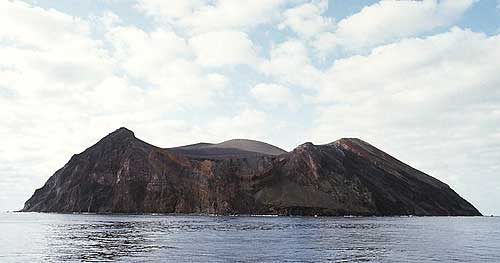Short- Tailed Albatross (Phoebastria albatrus)
Short- Tailed Albatross (Phoebastria Altatrus)
The Short- Tailed Albatross is the largest of the three North Pacific Albatross species. It belongs to the family Diomedeidae and the order Procellariiformes. It is a pelagic bird with long, narrow wings adapted for soaring above the water's surface. It has a large pink bill with a bluish hooked tip, a thin line around the base, and external nostrils. Their nests are on grounds lined with sand and vegetation. They eat squid, shrimp, fish, and other aquatic animals. As of 2008, 80-85% of the Short- Tailed Albatross lives in a single colony called Toroshima Island on an active volcano. Since the large majority of the species lives in Toroshima, the recovery plan mostly focuses on maintaining that specific population. It is managed by the Japanese government for conservation wildlife.  Toroshima Island
Toroshima IslandThe primary threat to the Short-Tailed Albatross to cause species decline was over-harvest. In the beginning of the twentieth century, the Short-Tailed Albatross declined in population numbers to near extinction due to hunting at breeding colonies in Japan. Their feathers were used for quilts, pillows, and writing quills. Bodies were processes into fertilizer, fat was rendered, and eggs were collected to be eaten.
The Short- Tailed Albatross was enlisted as an Endangered Species on 2 June 1970.
Estimated prior to exploitation there were 300,000+ breeding pairs in Toroshima alone. By the 1930s 3000 were killed. By 1949 they were thought to be extinct, until 10 birds were observed in Toroshima in 1950. By 1954 there were 25 birds. Since then recruitment rate has been 6-8%. There was an estimated 375 breeding pairs in Toroshima in 2007. Birds observed went fro 324 in 1995 to 635 in 2007.
 Colonies containing Short- Tailed Albatross (Largely concentrated in Japans and along Pacific Islands)
Colonies containing Short- Tailed Albatross (Largely concentrated in Japans and along Pacific Islands)One current threat to the Short- Tailed Albatross is the possibility of a catastrophic event taking place. There is a large eruption overdue on the volcano of Toroshima that may have the power to kill 54% of the world's Short-Tailed Albatross population. Volcanoes can also cause habitat destruction and loss. Monsoon rains also can occur, which create mud slides and nest destruction. Another threat to the species is climate change which can result in vegetation loss. Commercial fishing can also take their main source of food. Contaminants in the air, land, and ocean such as pollution, pesticides, metals, and oil can lead to impaired reproduction, decreased immune functioning, inability to thermoregulate, disrupted endocrine balances, genetic mutations, and direct mortality. Other threats include diseases and parasites, predation such as from sharks, natural competition, invasive species, collision with planes, and genetic factors.
The goal of the Recovery Plan is to bring about recovery to the Short- Tailed Albatross so that the Endangered Species Act would no longer be applied.
The Short-Tailed Albatross can be delisted and considered recovered if the total population of the species reaches a minimum of 100 pairs, there is a 3 year running average population growth rate of at least 6% for at least 7 years, and there are at least 250 breeding pairs on island groups other than the two main colonies on Toroshima and Senkaku Islands.
The Recovery Plan intends to reach this goal by completing a series of tasks:
- Population monitoring
- Breeding size enhancement to improve nests, remove volcanic ash, attract birds to alternate, well-vegetated site on the Northwest side of Toroshima that is less prone to lava, mudslides, and erosion
- Establish new colonies
- Satellite Telemetry by tracking movements with tags
- Supporting ongoing population monitoring and habitat management in Toroshima
- Erosion control
- Conducting decoy and sound-system maintenance in all colonies
- Continuing annual monitoring of Tsubamezaki and Hatsunezaki colonies on Toroshima
- Developing and employing appropriate leg bands
- Color coating for demographic information purposes
- Establishing nesting colonies on non-volcanic islands
- Monitoring and maintaining new colony sites
- Conducting fisheries related to bycatch reduction research and management
- Analyzing contaminants
- Investigating food habits
- Outreach and international negotiations
- Periodic recovery team meetings
- Translating Japanese to English and vice versa important documents.

Work Cited
Area 83. Digital image. Static Flickr, n.d. Web.
Bhattacharya,
Deepamala. Short- Tailed Albatross. Digital image. Short- Tailed
Albatross. Animal Spot, n.d. Web.
Bird View of
Toroshima Island. Digital image. Yamashina Institute for Ornithology.
N.p., n.d. Web.
Kelly, Katelin.
Among Laysan albatrosses, large, yellow-headed short tail albatross decoys
attract the critically endangered species. A single short tail albatross, one
of 4 on Midway, rests in the left side of the picture. Digital image. Marine
Conservation Biology in Hawaii. Duke: Nicholas School of Environment, 27
Jan. 2010. Web.
"Short-Tailed
Albatross (Phoebastria (=diomedea) Albatrus)." Environmental
Conservation Online System. US Fish and Wildlife Service, n.d. Web.
US Fish and Wildlife Service. 2008. Short- Tailed Albatross
Recovery Plan. Anchorage Alaska, AK, 105 pp.

No comments:
Post a Comment